Ancient Intriguing Sao People: “Men From Another Time” – One Of The Oldest Civilizations Of Central Africa
A. Sutherland - AncientPages.com - The Sao people - means "the men from another time" are an intriguing and one of the oldest civilizations of Central Africa.
Ancient civilization was developed by the Sao people in the region of Southeast of Lake Chad, located in the far west of Chad and the northeast of Nigeria.
Fragment of an anthropomorphic figurine in terracotta Sao. Image source.
The Sao civilization is identified by its use of stone and bone implements and the construction of walled cities.
This civilization flourished in Middle Africa from ca. the sixth century BC to as late as the sixteenth century AD. The Sao lived by the Chari River south of Lake Chad in territory that later became part of Cameroon and Chad. They are the earliest people to have left clear traces of their presence in the territory of modern Cameroon.
According to a Toubou tradition, the Sao originally come from a region about 500 kilometers north of Lake Chad. In the 7th century, they lived in the Bilma, Tadjeré, and Fatchi oases.
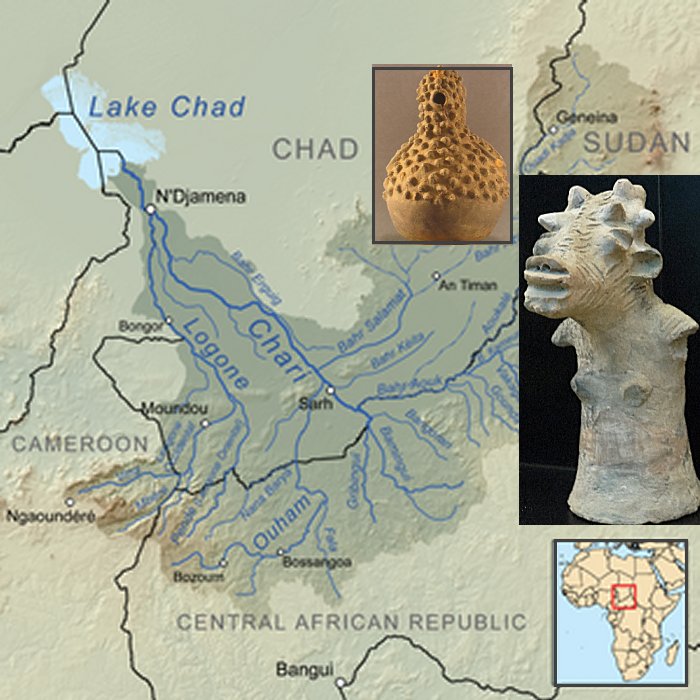
The Sao civilization may have begun as early as the sixth century BCE, and by the end of the first millennium BCE, their presence was well established south of Lake Chad and near the Chari River.
In the 11th century, the Sao, who were great architects, built large cities surrounded by dry earth walls complete with fortifications and ramparts. Sometime around the 16th century, conversion to Islam changed the cultural identity of the former Sao but they still claim descent from the civilization of the Sao.
It had long been suggested that the Sao were descendants of the Hyksos who conquered Ancient Egypt that they moved south from the Nile valley into middle Africa under pressure from invaders, or that they originated in the Bilma Oasis north of Lake Chad.
However, a more widely accepted theory is that the Sao people were simply the indigenous inhabitants of the Lake Chad basin and that their ultimate origins lie south of the lake. Recent archaeological studies suggest that the Sao civilization developed indigenously from earlier cultures in the region (such as the Gajiganna culture, which began at around 1,800 BC and began to build fortified towns by about 800 BC), which gradually increased in complexity.
Sao artifacts show that they were a sophisticated civilization working in bronze, copper, and iron. Finds include bronze sculptures, funerary urns, terra cotta statues of human and animal figures, coins, household utensils, jewelry, highly decorated pottery, and spears.
 Sao art. Museo di Quai Branly, Parigi. source
Sao art. Museo di Quai Branly, Parigi. source
Most of the archaeological finds related to the Sao people have been uncovered south of Lake Chad.
Studying Sao’s legacy, researchers discovered that these people buried their dead.
Tombs have been found, grouped in vast necropolises some of which had three, even four levels. The oldest of these tombs were simple pits where the corpse would be laid down on its back, the head resting on a kind of dried clay pillow.
The Sao people developed remarkable pottery especially large terra cotta earthenware jars, entirely or partially decorated with a herringbone pattern over which sexual motifs were added. A smaller earthenware jar, in which the deceased would be placed in the fetal position, was closed either by another jar of the same size placed upside down over the opening or more frequently by a smaller ovoid pot.
The tradition of placing the corpse in a jar dates from the 12th and 13th centuries. Beginning in the 15th century, this type of burial would start to be abandoned in favor of a simple burial. The culture’s terracotta animalistic and anthropomorphic sculptures represent the legacy that best attests to their civilization of Sao.
These intriguing figures – often associated with funerals - were discovered in the Sao’s sanctuaries and other places of offering.
Little is known about the Sao's culture or political organization because they left no written records and are known from oral traditions of the Sao and through archaeological discoveries. Sao artifacts show that they were skilled workers in bronze, copper, and iron.
Finds include bronze sculptures and terra cotta statues of human and animal figures, coins, funerary urns, household utensils, jewelry, highly decorated pottery, and spears.
The largest Sao archaeological finds have been made south of Lake Chad.
Written by – A. Sutherland AncientPages.com Staff Writer
Copyright © AncientPages.com All rights reserved. This material may not be published, broadcast, rewritten or redistributed in whole or part without the express written permission of AncientPages.com
More From Ancient Pages
-
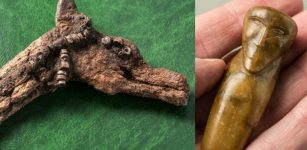 Ancient Doll And Mythical Animal – 4,500-Year-Old Toys Discovered In Siberia
Archaeology | Dec 30, 2017
Ancient Doll And Mythical Animal – 4,500-Year-Old Toys Discovered In Siberia
Archaeology | Dec 30, 2017 -
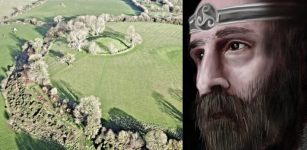 Massive Underground Anomaly – Iron Ages Temples And Seat Of Legendary Ulster Kings Discovered At Navan Fort?
Archaeology | Jul 21, 2020
Massive Underground Anomaly – Iron Ages Temples And Seat Of Legendary Ulster Kings Discovered At Navan Fort?
Archaeology | Jul 21, 2020 -
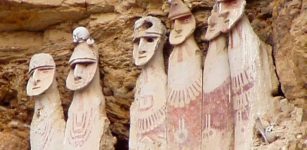 Genetic Evidence Reveals: Chachapoyas “Cloud People” Resistant To Inca Rule
Archaeology | Dec 14, 2017
Genetic Evidence Reveals: Chachapoyas “Cloud People” Resistant To Inca Rule
Archaeology | Dec 14, 2017 -
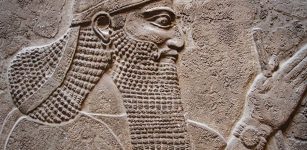 Unexpected Discovery Of 600 B.C Assyrian Palace In Shrine Destroyed By Isil Militants
Archaeology | Mar 2, 2017
Unexpected Discovery Of 600 B.C Assyrian Palace In Shrine Destroyed By Isil Militants
Archaeology | Mar 2, 2017 -
 Brutus Of Troy: First King Of Britain Or Just A Myth?
Featured Stories | Feb 16, 2016
Brutus Of Troy: First King Of Britain Or Just A Myth?
Featured Stories | Feb 16, 2016 -
 Freemasons Secrets – American Democracy Is Part Of An Ancient Universal Plan – Egyptian Temple And Legendary Expedition Hold The Clues – Part 2
Civilizations | Jul 13, 2018
Freemasons Secrets – American Democracy Is Part Of An Ancient Universal Plan – Egyptian Temple And Legendary Expedition Hold The Clues – Part 2
Civilizations | Jul 13, 2018 -
 Mada’in Saleh: Magnificent Timeless Rock-Cut Tombs And Monuments In The Desert
Civilizations | Oct 30, 2018
Mada’in Saleh: Magnificent Timeless Rock-Cut Tombs And Monuments In The Desert
Civilizations | Oct 30, 2018 -
 Riddle Of The Hanging Gardens Of Babylon – Highly Advanced Technologies – Part 2
Featured Stories | Jun 11, 2019
Riddle Of The Hanging Gardens Of Babylon – Highly Advanced Technologies – Part 2
Featured Stories | Jun 11, 2019 -
 Strange Ancient Sky Phenomenon – It Was Not A ‘Natural’ Space Object – Scientist Said
Ancient Mysteries | Nov 5, 2019
Strange Ancient Sky Phenomenon – It Was Not A ‘Natural’ Space Object – Scientist Said
Ancient Mysteries | Nov 5, 2019 -
 Mysterious Black Cloud Caused A Global Catastrophe In 536 A.D. And 18 Months Of Darkness
Featured Stories | May 25, 2021
Mysterious Black Cloud Caused A Global Catastrophe In 536 A.D. And 18 Months Of Darkness
Featured Stories | May 25, 2021 -
 Disappearance Of Neanderthals: Were Inbreeding And Demographic Shifts Responsible?
Archaeology | Nov 28, 2019
Disappearance Of Neanderthals: Were Inbreeding And Demographic Shifts Responsible?
Archaeology | Nov 28, 2019 -
 Incredibly Well-Preserved Viking Age Ski Discovered Under Melting Ice
Archaeology | Nov 8, 2022
Incredibly Well-Preserved Viking Age Ski Discovered Under Melting Ice
Archaeology | Nov 8, 2022 -
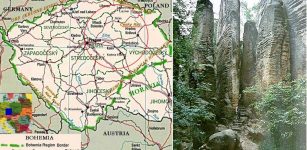 Bizarre Sandstone Towers Of The Rocky Town And Legend Of Jan Svatos Who Mastered Magic
Featured Stories | Sep 8, 2018
Bizarre Sandstone Towers Of The Rocky Town And Legend Of Jan Svatos Who Mastered Magic
Featured Stories | Sep 8, 2018 -
 Swedenborg: Man Of Unaccountable Talents, Scholar, Great Intellect And His ‘Spiritual Awakening’
Featured Stories | Jun 28, 2018
Swedenborg: Man Of Unaccountable Talents, Scholar, Great Intellect And His ‘Spiritual Awakening’
Featured Stories | Jun 28, 2018 -
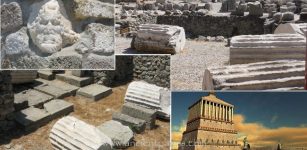 Halicarnassus’ Monumental Tomb Built With Shining Stones Belonged To Carian Ruler Mausolus
Featured Stories | Jul 20, 2016
Halicarnassus’ Monumental Tomb Built With Shining Stones Belonged To Carian Ruler Mausolus
Featured Stories | Jul 20, 2016 -
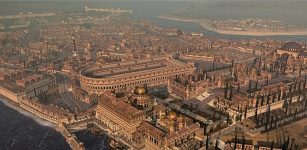 Why Was Constantinople Called New Rome?
Ancient History Facts | Mar 9, 2020
Why Was Constantinople Called New Rome?
Ancient History Facts | Mar 9, 2020 -
 Groundbreaking Study: First Known Case Of Down Syndrome In Neanderthals – Investigated
Archaeology | Jun 28, 2024
Groundbreaking Study: First Known Case Of Down Syndrome In Neanderthals – Investigated
Archaeology | Jun 28, 2024 -
 Fenrir: Oldest Of Three Monstrous Children Of God Loki In Norse Mythology
Featured Stories | Mar 28, 2018
Fenrir: Oldest Of Three Monstrous Children Of God Loki In Norse Mythology
Featured Stories | Mar 28, 2018 -
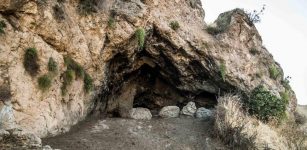 Artifacts And Remnants Of 3,000-Year-Old City Unearthed Near Great Zab River In Iraqi Kurdistan
Archaeology | Jun 5, 2017
Artifacts And Remnants Of 3,000-Year-Old City Unearthed Near Great Zab River In Iraqi Kurdistan
Archaeology | Jun 5, 2017 -
 Gold Dated To Scythian-Saka Era Unearthed In Valley Of The Kings In East Kazakhstan
Archaeology | Sep 14, 2020
Gold Dated To Scythian-Saka Era Unearthed In Valley Of The Kings In East Kazakhstan
Archaeology | Sep 14, 2020

